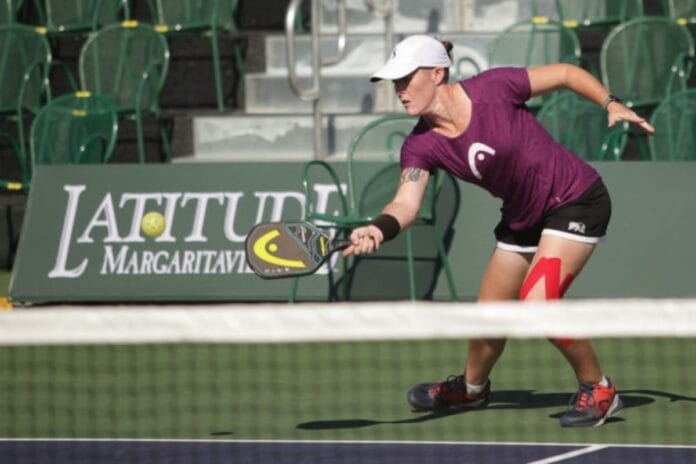Sarah Ansboury’s Forehand Volley Tips: Sarah Ansboury, a seasoned pickleball expert, highlights the significance of mastering the forehand volley to elevate one’s game. The fundamental difference between a dink and a volley lies in their motion: a dink involves a low-to-high trajectory, while a volley, specifically a punch volley, follows a high-to-low path. The crucial factor is getting the tip of the paddle on top of the ball, which effectively engages the shoulder.
The Role of Shoulder Engagement
Achieving a successful volley involves more than just swinging the paddle; it requires proper shoulder engagement. When practicing, players often use their wrist or elbow for power, but a well-executed volley relies on the shoulder. Sarah Ansboury, a noted pickleball coach, emphasizes the importance of this technique.
“When people throw a ball, they use their wrist or their elbow. But for a successful volley, engaging the shoulder is crucial.” – (Sarah Ansboury)
To begin, players should focus on their ready position, stepping and turning their bodies with minimal additional motion. The goal is not to strike the ball forcefully but to simply touch it. Aligning the shoulders with the shot is key, with the toe turn helping to set up the volley.
“As you turn your toe, align your shoulders for the shot.” – (Sarah Ansboury)
Practicing the Basics
Ansboury recommends starting with basic drills to establish proper form. Initially, players should practice the motion without the ball, concentrating on keeping their hands up and maintaining a smooth, upward motion. Once comfortable, they can incorporate the ball, focusing on a light touch rather than a powerful hit. This approach helps players avoid unnecessary large motions and ensures a more controlled and precise volley.

A useful drill involves mimicking the motion with the paddle while keeping the head up. The next step is to add the ball, aiming to “touch” it rather than forcefully strike it. As players become more proficient, they can progress to pushing the ball deeper while incorporating a freeze tag exercise. This exercise helps players maintain readiness by practicing stopping and resetting after each volley.
Avoiding Common Mistakes
One common pitfall is the tendency to drop the elbow or misalign the hands. Ansboury warns against this, advising players to keep their elbows down and hands up. The motion should be more outward and away from the body, in contrast to the tennis-style volley that involves a more inward approach.
“Often we think of like a tennis volley that is not what we’re doing. We’re thinking more out and away from the body.” – (Sarah Ansboury)
Advancing Your Skills
As players progress, integrating these techniques into regular practice will enhance their volleying ability. Maintaining the focus on shoulder engagement and proper form will lead to greater consistency and effectiveness in play. With dedicated practice, the forehand volley becomes a powerful and reliable tool in any pickleball player’s arsenal.
For those seeking further guidance, Sarah Ansboury’s Pickleball Academy offers an online platform with a range of instructional materials, from courses and lessons to drills and workouts. This resource provides an opportunity to refine skills and gain insights from a seasoned expert, ensuring continued improvement in the art of the forehand volley.

News in Brief: Sarah Ansboury’s Forehand Volley Tips
Sarah Ansboury, a pickleball expert, shows the importance of mastering the forehand volley to improve gameplay. Unlike a dink, which has a low-to-high trajectory, a volley, especially a punch volley, moves high-to-low. Proper shoulder engagement is crucial, as Ansboury emphasizes that using the shoulder, not just the wrist or elbow, enhances power and control.
She advises starting with basic drills to build form, focusing on a light touch, and aligning shoulders with the shot. Common mistakes include dropping the elbow or misaligning hands; instead, players should keep their elbow down and hands up. Advanced practice and Sarah Ansboury’s Pickleball Academy offer further resources for refining these skills.

